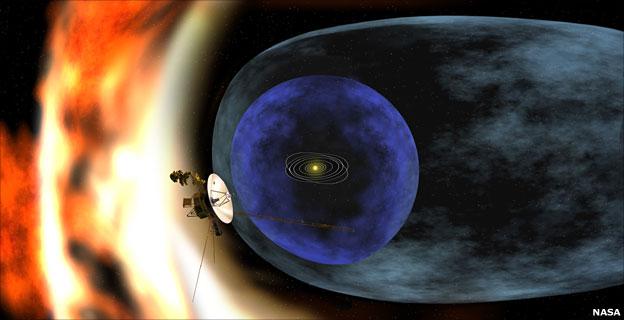Probe in deep space
 Bashny.Net
Bashny.Net
"Voyager-1» (Voyager 1), an American interplanetary automatic probe has departed furthest from the planet and who is now 17, 4 billion miles from Earth, recorded a change in the flux of particles, reports BBC News. These particles coming from the sun ceased to move away from him and began to move toward. This means that "Voyager" approaching interstellar space. Edward Stone (Edward Stone), a scientist from the project "Voyager", made a presentation on the new data "Voyager" at the conference, hosted by the American Geophysical Union (American Geophysical Union).

"When" Voyager "was launched, we went out into space only 20 years old, so we did not have any reason to think that the probe can last so long. We had no idea how many will have to fly to get out of the solar system. Now we know that in about 5 years, we will be able to look out for the first time "outside", "- said Edward Stone.
"Voyager 1" was launched into space Sept. 5, 1977, and "Voyager 2" - 20 August of the same year. The original purpose of NASA (NASA) was a study of the upper planets - Jupiter, Saturn, Uranus and Neptune. This task was completed in 1989, after which the probes were directed toward the center of our galaxy. And still later probes were redirected toward deep space.
Recall that in 2004, "Voyager 1" has reached the so-called border of a shock wave in which particles of the solar wind begins to slow to speeds below supersonic and collide with matter from outer space. In 2007, "Voyager 2" crossed the border and headed for the heliopause - the boundary separating the interstellar medium on the substance of the Solar System. Heliopause, which has an asymmetric structure, elongated relative to the sun from north to south - perhaps under the influence of ultra-low magnetic fields. It is assumed that the probe will retain its functionality until 2020, after which the connection to the station stops due to wear of its energy generators.
Source:

"When" Voyager "was launched, we went out into space only 20 years old, so we did not have any reason to think that the probe can last so long. We had no idea how many will have to fly to get out of the solar system. Now we know that in about 5 years, we will be able to look out for the first time "outside", "- said Edward Stone.
"Voyager 1" was launched into space Sept. 5, 1977, and "Voyager 2" - 20 August of the same year. The original purpose of NASA (NASA) was a study of the upper planets - Jupiter, Saturn, Uranus and Neptune. This task was completed in 1989, after which the probes were directed toward the center of our galaxy. And still later probes were redirected toward deep space.
Recall that in 2004, "Voyager 1" has reached the so-called border of a shock wave in which particles of the solar wind begins to slow to speeds below supersonic and collide with matter from outer space. In 2007, "Voyager 2" crossed the border and headed for the heliopause - the boundary separating the interstellar medium on the substance of the Solar System. Heliopause, which has an asymmetric structure, elongated relative to the sun from north to south - perhaps under the influence of ultra-low magnetic fields. It is assumed that the probe will retain its functionality until 2020, after which the connection to the station stops due to wear of its energy generators.
Source:
Tags
See also
The darkest planet with all that we know
Dark Planet
Man in Space!
Summary of the Soviet space exploration, types of rockets and the most significant victories in this field. Part 1
How to map the planet conquered
The space race (32 photos)
5 most famous
Russian astronautics
The mystery of the fourth planet
Nibiru, Planet Heh, unknown nonsense from Space

















